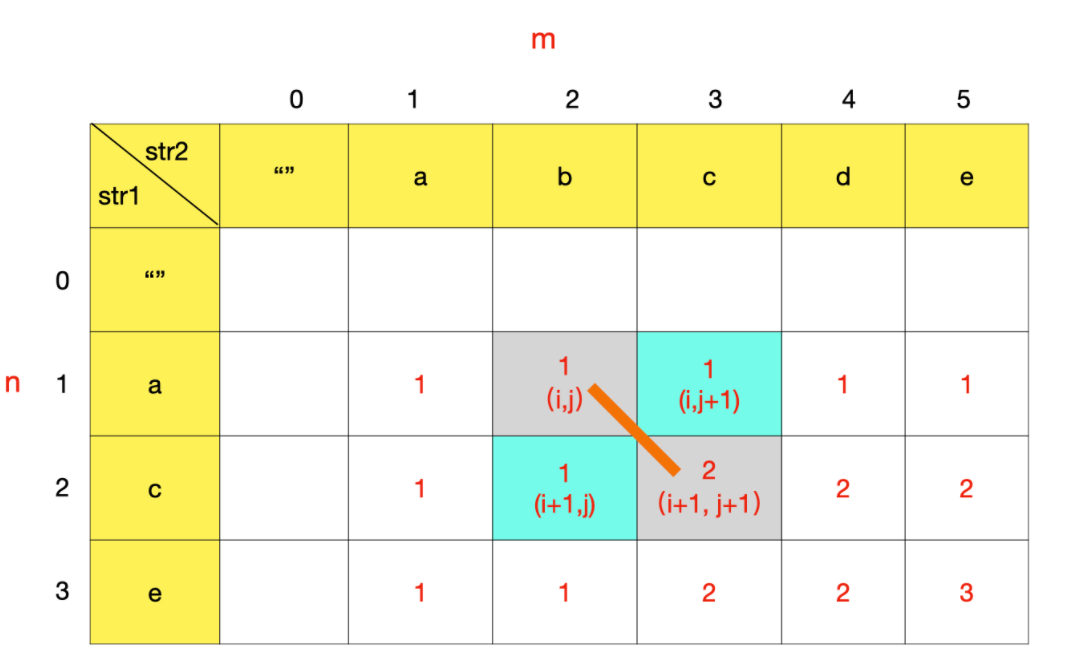1143. 最长公共子序列
约 650 字大约 2 分钟
1143. 最长公共子序列
题目描述
给定两个字符串 text1 和 text2,返回这两个字符串的最长 公共子序列 的长度。如果不存在 公共子序列 ,返回 0 。
一个字符串的 子序列 是指这样一个新的字符串:它是由原字符串在不改变字符的相对顺序的情况下删除某些字符(也可以不删除任何字符)后组成的新字符串。
例如,"ace" 是 "abcde" 的子序列,但 "aec" 不是 "abcde" 的子序列。 两个字符串的 公共子序列 是这两个字符串所共同拥有的子序列。
示例:
输入:text1 = "abcde", text2 = "ace"
输出:3
解释:最长公共子序列是 "ace" ,它的长度为 3 。
解题思路
动态规划。
解法一:dp[i][j]表示text1以i-1结尾的子串和text2以j-1结尾的子串的最长公共子序列的长度。dp横坐标或纵坐标为0表示空字符串,dp[0][j] = dp[i][0] = 0,无需额外处理base case。

class Solution {
public int longestCommonSubsequence(String text1, String text2) {
char[] arr1 = text1.toCharArray();
char[] arr2 = text2.toCharArray();
//dp[0][x]和dp[x][0]表示有一个为空字符串
//dp[1][1]为text1第一个字符和text2第一个字符的最长公共子序列的长度
//dp[i][j]表示text1以i-1结尾的子串和text2以j-1结尾的子串的最长公共子序列的长度
int len1 = arr1.length;
int len2 = arr2.length;
int[][] dp = new int[len1 + 1][len2 + 1];
for (int i = 1; i < len1 + 1; i++) {
for (int j = 1; j < len2 + 1; j++) {
if (arr1[i - 1] == arr2[j - 1]) {
dp[i][j] = dp[i - 1][j - 1] + 1;
} else {
dp[i][j] = Math.max(dp[i - 1][j], dp[i][j - 1]);
}
}
}
return dp[len1][len2];
}
}
解法二:dp[i][j]表示text1以i结尾的子串和text2以j结尾的子串的最长公共子序列的长度。需要处理base case。
class Solution {
public int longestCommonSubsequence(String text1, String text2) {
char[] arr1 = text1.toCharArray();
char[] arr2 = text2.toCharArray();
int len1 = arr1.length;
int len2 = arr2.length;
//`dp[i][j]`表示text1以i结尾的子串和text2以j结尾的子串的最长公共子序列的长度。
int[][] dp = new int[len1][len2];
if (arr1[0] == arr2[0]) {
dp[0][0] = 1;
}
for (int i = 1; i < len1; i++) {
if (arr1[i] == arr2[0]) {
dp[i][0] = 1;
} else {
dp[i][0] = dp[i - 1][0];
}
}
for (int i = 1; i < len2; i++) {
if (arr1[0] == arr2[i]) {
dp[0][i] = 1;
} else {
dp[0][i] = dp[0][i - 1];
}
}
for (int i = 1; i < len1; i++) {
for (int j = 1; j < len2; j++) {
if (arr1[i] == arr2[j]) {
dp[i][j] = dp[i - 1][j - 1] + 1;
} else {
dp[i][j] = Math.max(dp[i - 1][j], dp[i][j - 1]);
}
}
}
return dp[len1 - 1][len2 - 1];
}
}